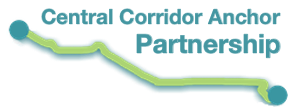The Partnership worked with Metro Transit to design a transportation survey for Anchor employees to provide a better picture of existing transit use and help identify ways to improve the transit outreach and transit passes. In the fall of 2013 each CCAP institution was asked to distribute an electronic or paper survey to staff, students and faculty asking about their commute patterns, transit usage and attitudes toward transit.
A total of 4,330 surveys were completed which represented a response rate of about 3% of total staff, students and faculty.
The strongest participation came from the University of Minnesota, University of Minnesota Medical Center, Fairview, Minneapolis Community and Technical College and St. Paul College.
Almost half of all commuters overall and in the Corridor are traveling within the core cities. For facilities in the Corridor, this highlights the importance of maintaining and strengthening an intra-city network of sustainable transportation access. The Green Line will need convenient transit connections, bicycle infrastructure, and safe pedestrian access to support the urban commuter.
Approximately 1/3 of commuters, both overall (33.6%) and in the Corridor (36.1%), are using more than one mode to get from home to work or school.
Image courtesy of Streets.MN
Among multimodal commuters, driving alone and riding the bus are the most common trip legs. Drivers were most likely to value reduced travel times, convenience, and flexibility. They perceive driving to be the fastest, most convenient, and most flexible way to commute. Transit riders, on the other hand, are much most cost conscious.
Approximately 1/2 of commuters identified low cost as one of the factors contributing to their decision to use transit.
Since more than 1/3 also valued the availability of a discounted transit pass, it is likely that most transit users who perceive transit as a lower cost option also have access to a subsidized transit pass like UPass, College Pass, or Metropass.
As cost and convenience are the primary factors weighed by commuters, we attempted to gather information about parking and transit stop convenience as well as parking and transit costs.
Most commuters (80.6%) park next to or within 3 blocks of their work or school.
The themes of cost and convenience carry through commuters identified what factors would cause them to consider using transit. The most common factors chosen were reduced commute time, increase transit trip frequency, and availability of a discounted transit pass. Similarly, the most common “other” factors were related to convenience; most indicated desire for one or fewer transfers. It’s promising to see that most commuters who currently do not use transit are not opposed to using it in the future.
Transit stops are less convenient; only about 1/3 have a transit stop less than 4 blocks away.
According to the results, commuters were only vaguely aware of the Green Line. There was confusion over costs, frequency, the schedule, and the route. Each institution has the opportunity to educate its own employees and student about the Green Line and how it may impact their commute.
Image courtesy of Metro Transit




